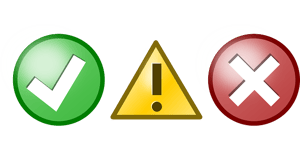3 Ways to Improve Your Premarket Submission Documentation
Submitting your life science product for premarket review is a stressful endeavor; if it is rejected by regulators for insufficient documentation or other issues, it can result in lost time to market and loss of time and resources in remediation. Overcoming those issues is not an easy thing, and knowing what to do is not readily apparent. However, there are three important strategies your organization can use to improve your premarket submission documentation, potentially reducing the likelihood of rejection.
1. Traceability
For ensuring clarity and thoroughness of your premarket development activities, it’s important to make use of robust traceability in your submission. Documents and data should have clear links to each other up and down your requirements flow. Doing so overcomes two big obstacles many life science organizations face in the submission process.
 First, traceability confirms clear links between your design inputs and outputs. This is essential for your design validation activities. In addition, it makes it easier to show how your user needs are being met by those outputs and product requirements.
First, traceability confirms clear links between your design inputs and outputs. This is essential for your design validation activities. In addition, it makes it easier to show how your user needs are being met by those outputs and product requirements.
The other major hurdle in premarket submission that traceability can help with is showing risk analysis has been carefully managed throughout the development process. As the results of your risk management activities are generated, incorporating them into the product inevitably affects your final design and functionality. With traceability in place, you can show how this incorporation was managed and accounted for in your development process.
2. Robust Risk Management
Beyond just having traces to risk analysis in your premarket submission documentation, you need to show evidence of active risk management. This is highly important, as it aids in proving your life science product’s safety and efficacy. Reviewers usually work with this information to conduct risk-benefit analyses prior to approving your product, so having documentation of a functioning, in-depth risk management program is crucial for premarket submission.
 What that program looks like depends on your organization’s capabilities, resources, and needs, as well as the product type and its risk profile. What is most important is that the risk analysis activities you undertake and document in your submission are appropriate. For example, if your life science product has a higher risk profile and a complex user interface, it may be more important to focus on risk management exercises such as use error analysis versus an FMEA.
What that program looks like depends on your organization’s capabilities, resources, and needs, as well as the product type and its risk profile. What is most important is that the risk analysis activities you undertake and document in your submission are appropriate. For example, if your life science product has a higher risk profile and a complex user interface, it may be more important to focus on risk management exercises such as use error analysis versus an FMEA.
It’s also critical to show in your premarket submission documentation how the results of your risk activities have been included in the product design and how any residual risk has been identified and controlled. This iterative approach to risk management can assure regulators that product safety and efficacy have been prioritized in your product development processes.
3. Well-Defined Processes and Procedures
The final factors that can really make a difference with your submission documents are well-defined processes and procedures. When associated with the necessary compliance activities your organization needs to undertake, a strong design and development plan can make a world of difference in the premarket review of your product.
 The strength of this plan relies on a number of things. First, goals and outcomes need to be adequately established and communicated. For your teams to generate the necessary data and documents for your premarket submission, there needs to be an alignment of visions to focus work, reduce waste, and verify that design principles are being upheld. Second, your teams need timely training around your current development processes and procedures. This training reinforces your plan and ensures the right people are working on the appropriate tasks and activities necessary to make your life science product.
The strength of this plan relies on a number of things. First, goals and outcomes need to be adequately established and communicated. For your teams to generate the necessary data and documents for your premarket submission, there needs to be an alignment of visions to focus work, reduce waste, and verify that design principles are being upheld. Second, your teams need timely training around your current development processes and procedures. This training reinforces your plan and ensures the right people are working on the appropriate tasks and activities necessary to make your life science product.
Finally, your design and development plan’s strength can be bolstered through the implementation of work instructions and SOPs. When constructed with compliance in mind, these documents can be leveraged to produce submission-ready records from the start. This helps your teams worry less about generating product data ready for compliance, and reduces the overall burden of putting together regulatory information for the premarket submission process.
About Cognition Corporation
At Cognition, our goal is to provide medical device and pharmaceutical companies with collaborative solutions to the compliance problems they face every day, allowing the customer to focus on their products rather than the system used to create them. We know we are successful when our customers have seamlessly integrated a quality system, making day-to-day compliance effortless and freeing up resources to focus on product safety and efficacy.




